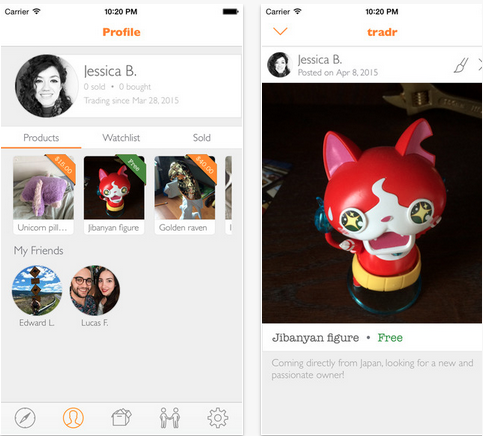As developers look to ensure a sleek, frictionless experience for app users, more and more of them have been adopting a Tinder-style interface. It makes sense, too: After all, what could be more simple yet engaging than swiping left or right to do everything from order a meal to play a song. A perfect example of this trend? Tradr, which leverages Tinder’s experience for the purposes of product discovery.
Built at the Harvard i-lab, the iPhone app allows you to buy, sell and trade handmade or vintage local goods. To browse available products, users swipe right if they “like” the item and swipe left if they want to pass on it. And beyond just helping people to make money off stuff they don’t use, Tradr is also meant to empower up-and-coming designers. To date, people have bought and sold everything from a vintage polaroid camera to an antique wall clock and a handmade jaguar terrarium on Tradr.
Here’s how it works. To sell a product, a user uploads a picture of it through the app or chooses an existing one from their photo library, assigns a category to it, writes a brief description and sets the price. If a user “likes” the item while perusing, they can either initiate a negotiation via the app’s messaging function or continue browsing—in which case the object is saved to their “treasure trove” for future reference.
As a user “likes” and “dislikes” items, Tradr gets smarter, and the algorithm curates the objects a user will see based on their learned tastes and inclinations. There’s a social element, too: Users are encouraged to share their uploads, transactions or any items they find while browsing on social networks.

As for how the idea came about: two young entrepreneurs were struggling with two separate but related challenges from separate corners of the world. In Brazil, Jessica Behrens wanted to de-clutter her life and thus, committed to give away one material possession every day for an entire year—something that was tougher than she expected.
Meanwhile, at Harvard University, Zaki Djemal and a team of behavioral economists were experimenting with different methods of encouraging people to be more conscious of how they spend their money. According to their research, peoples’ purchasing decisions are influenced not only by the information available to them at the time of evaluation, but also by how that information is organized and displayed to them. The binary framework Tinder is known for—swipe right or left for yes or no—makes decisions easy and intuitive, which they realized could help consumers who struggle with too many options.
What if, they wondered, people were presented with a deck of quality items—the kinds of treasures you’d find in thrift stores, on Craigslist or eBay—on their smartphones? What if selling an item was a 10-second task: Snap a photo and post it with a single click? And what if shopping was as simple as swiping left or right on goods? Thus, Tradr was born. For both co-founders, the idea posed dual advantages: A way to get rid of unwanted things, and also provide people who might use or want them with an easy decision-making process.
Currently, there are 12 people working on Tradr: six in the U.S. and six in Brazil. After a successful beta launch with the Harvard community in May, the startup secured seed funding from an unnamed angel investor. The iPhone app officially launched at the end of June, and has amassed about 1,200 users—seeing 90 percent growth in the last week alone. The team expects the Android app to be available by the end of September.
Already, Tradr has been in talks with strategic partner investors to support its go-to-market efforts in the U.S. and in Brazil. Among their top priorities right now are to secure additional seed funding, find a technical lead in Brazil, and implement new features—like a newsfeed, groups, and following capabilities. The current goal is to grow the user base to 10,000 to further demonstrate traction.
All images courtesy of Tradr.

